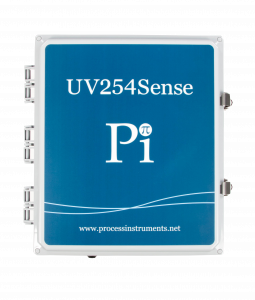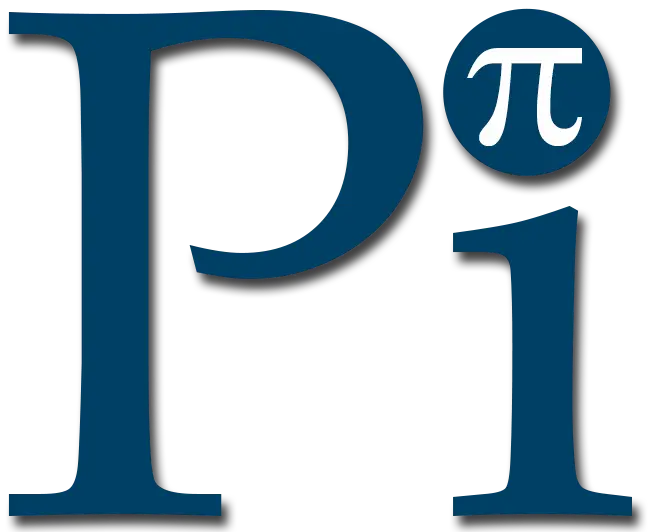UV254 Analyser – UV254Sense
 The UV254Sense UVA/UVT monitor provides real time organic UVA (ultra-violet absorbance) and UVT (ultra-violet transmission) analysis.
The UV254Sense UVA/UVT monitor provides real time organic UVA (ultra-violet absorbance) and UVT (ultra-violet transmission) analysis.
The real time monitoring of organics in water has improved greatly with technological improvements in spectral analysis of the ultraviolet light range using the UV254 analyser which as standard comes with UV transmittance and UV absorbance outputs. It does this by passing a low flow of water continuously through a fixed silica cuvette and by shining a UV254 light through the water measuring how much is absorbed (UVA) and how much is transmitted (UVT).
The concentration of contaminants such as the organics that lead to disinfection by products (DBPs) can be determined by measuring the light absorbed by a water sample at a particular wavelength (254nm). The absorbance of light used in UV254 monitors provides an indication of the amount of aromatic (or reactive) organic matter in water, making it an excellent choice as a surrogate measurement for total organic carbon (TOC) in monitoring organics removal from a process.
UV254 analysers from Pi allow for the detection of natural organic matter (NOM) which is found in all waters and has a bias towards aromatic compounds which provides significant benefit for monitoring DBP formation potential.
“… UV254, which is generally linked to the aromatic and unsaturated components of NOM, is considered a good predictor of the tendency of a source of water to form TTHM & HAAS”
– EPA – Stage 2 Disinfectants & Disinfection By-products Rule Operational Evaluation Guidance Manual
- UVA (ultra-violet absorbance) is an excellent surrogate parameter for TOC, DOC, COD and colour.
- UVT (ultra-violet transmission) allows for the calculation of optimal UV dose for disinfection systems, improving efficiency.
- Accurate detection without the cost of reagents.
- Few ongoing service or maintenance requirements.
- Allows feed forward optimisation of coagulation control, resulting in decreases in chemical consumption, reduction in sludge removal costs and minimisation of DBP formation potential.
- Strong ROI with pay back on the analyser being seen by many customers within a few months.
- UVA measurement ensures performance of various contaminant removal technologies such as membranes (RO, NF, UF), ion exchange (nitrates and TOC removal) and granular activated carbon (GAC).
- Real time UVA analysers can provide a final check of effluent water quality and can alarm an operator in case of non-compliance.
- A UVA monitor can monitor the percentage removal of organics across any treatment system.
- Can be combined with a CRONOS® or CRIUS®4.0 for a multi-parameter UV254 analyser solution that suits your needs.
Standard Features
- Online continuous operation
- Patent pending Ortho-Beam technology
- 254nm wavelength UV light source
- Displays UV transmittance or absorbance values
- UVT (ultra-violet transmission)
– the primary application for UV transmission monitoring is to control the intensity of UV light output on UV disinfection processes. - UVA (ultra-violet absorbance) – the primary application for UV absorbance monitoring is in the optimisation of water treatment process by, for example controlling coagulant dose or by providing a surrogate measurement for measurands such as TOC or COD.
- Process control – direct measurement of a parameter to control a process such as coagulation, UV disinfection and membranes.
- Specific parameter correlation – correlated to another parameter that is impractical or expensive to measure in real time such as TOC, BOD and COD.
- Event monitoring – used to monitor baseline absorbance which can trigger an alarm when an absorbance event occurs such as security monitoring for contamination events in a municipal installation.
- Industrial water and wastewater secondary and effluent monitoring, to determine treatment efficiency after secondary treatment and provide tertiary treatment monitoring and control.
 Many water treatment plants still use manual control for coagulant dosing (usually alum or ferric). Whilst the raw water quality is steady this is an effective method to get a coagulant dose, however when the raw water changes then manual control of the coagulant dose breaks down, particularly when plants are unmanned overnight or over the weekend.
Many water treatment plants still use manual control for coagulant dosing (usually alum or ferric). Whilst the raw water quality is steady this is an effective method to get a coagulant dose, however when the raw water changes then manual control of the coagulant dose breaks down, particularly when plants are unmanned overnight or over the weekend.
When the raw water is likely to be of proper quality in the future (e.g. a weather forecast predicts a rain event) operators often increase the coagulant dose in anticipation of a rainfall event. This can lead to poor coagulation prior to, during, and after the rainfall event (if it comes at all) and also can introduce longer term issues such as filter blinding, shorter filter run times and increased aluminium residuals (in the case of alum).
For many plants it is possible to automate coagulant control such that a streaming current monitor can effectively increase and decrease the dose of coagulant automatically in response to changing water quality. This is particularly common in areas of low alkalinity raw water.
- Automatic chemical cleaning system
- Dual sample feed capability
- Multiple sensors on a single analyser
By shining a light of a particular wavelength (254nm) through water you can measure how much of the light is absorbed by contaminants in the water. This may be particulate or it may be organics that absorb at that wavelength.
In two main ways.
The first is to measure the transmission of UV light (Ultra Violet Transmittance). This is essential in determining the power of UV light used for disinfection purposes.
The second is to measure the UV absorption (UVA). This is a measure of the organics in the water and can be used as a surrogate for TOC, DOC, COD. It is more commonly used in coagulation control on water treatment works.
UVA = 2-log10UVT.
UVA and UVT are essentially the same measurement expressed in different ways.
Coloured raw water is often caused by organics in the water and therefore both UV and colour can be used to measure the same thing. Colour monitors are useful to determine the acceptability of the look of drinking water but many organics do not reflect in the visible spectrum (have no colour) and many other things can cause colour in water such as manganese. UV254 measurement is more sensitive to aromatics in the water which can go on to react with chlorine to make unwanted DBPs (Disinfection By-Products) and so is usually seen as a more useful measurement than colour, particularly for coagulation control.
Pi’s UV254Sense also measures absorbance at another wavelength closer to visible light where organics have no absorption. This allows the UV254Sense to continuously compensate for turbidity in the water.
TOC (Total Organic Carbon) is a difficult and expensive measurement to make online and UV254 can often be used as a surrogate measurement. This requires the user to build a correlate between TOC and UV254 offline and then enter the relationship between the two into the analyser which can then output as TOC (effectively, correlating the UV254 output to TOC). How good this correlation is will depend on what makes up the TOC. If the TOC is made up entirely of UV254 absorbing organics then the correlation will be excellent. If not the correlation will become predictably poorer until TOC is made up entirely of non-absorbing organics when the correlation will be 0. Typically, municipal water and wastewater have very good correlations.
Focus Ons are a series of short articles distributed by email providing technical information regarding instrumentation, process measurement in potable, waste, process and pool waters. If you would like to join the mailing list, please contact us.
Process Instruments (Pi) is known for making the best online water quality analysers on the market. However, did you know that…
…Pi also supplies standalone laboratory based analysers for determining coagulant dose in 5 minutes?
…Pi also manufactures and supplies portable versions of some of their online water analysers?
This Focus On will highlight some of the features of Pi’s LabSense and ChargeSense Laboratory Charge Analysers and Pi’s UV254 Portable Meter.
LabSense
 Pi’s range of LabSense Laboratory Charge Analysers are an essential coagulation optimisation tool for water treatment. LabSense allows the user to determine the ideal coagulant dosage needed to achieve optimum NTU and TOC reduction in typically less than 5 minutes, earning it the description “5 minute jar tester”.
Pi’s range of LabSense Laboratory Charge Analysers are an essential coagulation optimisation tool for water treatment. LabSense allows the user to determine the ideal coagulant dosage needed to achieve optimum NTU and TOC reduction in typically less than 5 minutes, earning it the description “5 minute jar tester”.
How does it work?
Based on streaming current technology, the LabSense titrates a sample of raw water to determine the dose of coagulant required to achieve charge neutralisation. The LabSense, which has been shown to be an accurate approximation for coagulant dosage, is proving an invaluable tool for a Water Process Scientist with the responsibility to optimise coagulant dosage often on rapidly changing water sources where jar testing can just take too long.
For more information about Pi’s LabSense Laboratory Charge Analyser, click here.
ChargeSense
Pi’s ChargeSense Laboratory Charge Analyser is an essential tool for papermaking allowing fast determination of wet end charge demand.
How does it work?
ChargeSense measures the streaming current produced by colloidal/dissolved species in a sample taken from various points on the wet end of the papermaking process, and allows for a titration with a poly-electrolyte titrant to bring the sample’s charge to zero. The charge demand result is then expressed as either microequivalents per litre (µeq/L) or parts per million (ppm).
For more details about Pi’s ChargeSense Laboratory Charge Analyser, click here.
UV254 Portable
 With the UV254 Portable range of UV254 hand held meters you get a simple and reliable means of testing any water for UV transmittance (UVT) and UV absorbance (UVA). Used to provide quick (less than 1 min) information on site, the UV254 Portable provides an invaluable tool to water treatment engineers, essential for verifying an online analyser reading or as an independent measurement.
With the UV254 Portable range of UV254 hand held meters you get a simple and reliable means of testing any water for UV transmittance (UVT) and UV absorbance (UVA). Used to provide quick (less than 1 min) information on site, the UV254 Portable provides an invaluable tool to water treatment engineers, essential for verifying an online analyser reading or as an independent measurement.
How does it work?
The Pi UV254Sense Portable for the measurement of UV254 absorbance and UV254 transmission can provide testing in both units of UVT and UVA, and any of the meters can be equipped with our optional battery pack feature, allowing the meter to truly go anywhere, anytime.
The patented Split-Sensor technology also allows for the unique ability to remember the meter’s calibration, eliminating the need to calibrate (zero) the meter to a known pure (DI) water source before taking a measurement. This improves ease of use in the field for performing rapid grab sample testing of various water sources.
For more information about Pi’s UV254Sense analysers, click here.
 You probably know that the UV254 water quality parameter is a measurement of the absorbance of light by a water sample at 254nm wavelength and often can be used to correlate with other water quality parameters but did you know that…
You probably know that the UV254 water quality parameter is a measurement of the absorbance of light by a water sample at 254nm wavelength and often can be used to correlate with other water quality parameters but did you know that…
…the absorbance can be used as a cheaper, easier and more reliable surrogate than online TOC or COD?
…the total cost of ownership of a UV254 instrument is a very small fraction of the cost of, for example, a TOC instrument?
…although it is possible for there to be no correlation between UV254 absorbance and other water quality parameters in natural water or waste water, there is usually a simple linear relationship between UV254 and TOC?
UV254 Absorbance
UV254 is an optical technology which utilises light in the UV at a wavelength of 254nm and is able to detect organic matter in the water. Typically, its measurement is presented as a calculation of UV absorbance (UVA) or UV transmittance (UVT). Absorbance measurements are very common in the laboratory and in the field since absorbance at a given wavelength is linearly proportional to the concentration of any substances in the water that are known to absorb light at the given wavelength.

Correlating UV254 to other Organics
Light at 254nm wavelength is of particular interest since it is a wavelength that is very readily absorbed by organic matter in the water. Because the UV254 absorbance parameter is proportional to the concentration of organics in the water, it is a simple process to determine a linear correlation factor that relates the UV254 parameter to other water quality parameters that provide a measure of organic matter in the water. There are several such water quality parameters including total organic carbon (TOC), chemical oxygen demand (COD), biological oxygen demand (BOD) and colour (Hazen). All these parameters have slightly different biases to different types of organic matter. UV254 can often be linearly correlated to all of these parameters.*

The correlation factor will depend on the particular organic water quality parameter being correlated to and will also depend on the matrix of organics being measured. This means that correlations are site and application specific and so the correlation factor must be determined at the measurement site.
Most natural water sources such as raw water for drinking water and municipal waste water have a good correlation between, for example TOC and UV254 absorption, and COD and UV254 absorption.
The solution from Pi
The UV254Sense is a practical solution to a correlated UV254 absorbance signal to, for example TOC.

The way the Pi UV254Sense provides an output for a correlated parameter is by applying an offset and calibration to the UV254 measurement. This is calculated by setting up a ‘virtual channel’ in the instrument. This channel is then related to the original UV254 measurement by way of a formula in the form of y = ax + b where
y is the correlated water parameter (eg. TOC, COD)
x is the UV254 absorption
a is a factor to be applied to x (changing the slope)
b is an offset (changing the zero).

In order to calculate a and b, sufficient data must be collected over time to generate a graph similar to the graphs on the right. A spreadsheet program can then fit a straight line to the data and provide a formula in the form y = ax + b in order for it to be entered into the Pi UV254Sense.
The virtual correlated channel can then be used as a measurement parameter to generate alarms, control a PID loop, display on the instrument etc.
In order to derive a correlation between TOC, DOC, BOD, or COD and UVA, data will need to be gathered using both parameters over a period of time.
*Please note that it is possible for there to be no correlation between UV254 absorbance and other water quality parameters if that parameter on a particular water source does not contain UV254 absorbing substances. An example of this would be a water supply counting a lot of dissolved sugar, as sugar won’t absorb UV254 but will have a high Chemical Oxygen Demand (COD).
Most people in the water treatment industry know that achieving the correct coagulant dosing level can be challenging at times. Maintaining an optimum dosage is crucial to achieving the best water quality possible, which includes an optimum reduction in organics for disinfection by-product (DBP) control. A plant operator may use historical data, jar tests, or experience to decide on their dosing level. To avoid the possibility of under dosing and releasing poorly treated water, many water treatment plants end up over dosing which results in large unnecessary chemical costs, reduced filter run times, reduced organics removal, aluminium carry over, increased sludge treatment costs etc..
However, did you know that…
…no single online water quality measurement stands out as always being the best to monitor or control coagulation in all situations (as there are multiple factors that can affect coagulation)?
…some of these factors, like organics, are very critical to coagulation but are not commonly measured online and so are often overlooked?
…Process Instruments controllers can monitor multiple parameters simultaneously including charge (streaming current), organics (UV254), pH, flow rate and turbidity to provide a complete overview of water characteristics minute by minute?
What is coagulation control?
 The aim of water treatment is to remove soluble (e.g. organics) and insoluble (e.g.colloidal particulate) contaminants. These contaminants often carry an anionic charge which keeps them in suspension or in the soluble phase. Coagulants are added to neutralise the charge of colloidal particles and to also “complex” with organic molecules which ultimately results in their precipitation. Reducing the charge of the particles and precipitating the organics means they will no longer be able to remain in a stabilised suspension. Once the repulsive charge component is removed these contaminants will naturally start to clump together due to attraction forces called Van Der Waals forces. The removal of these contaminants is aided by the formation of chemical floc (resulting from the hydrolisation of the coagulant) that both enmeshes and sweeps up the smaller agglomerations, so they can be removed more easily by sedimentation or flotation.
The aim of water treatment is to remove soluble (e.g. organics) and insoluble (e.g.colloidal particulate) contaminants. These contaminants often carry an anionic charge which keeps them in suspension or in the soluble phase. Coagulants are added to neutralise the charge of colloidal particles and to also “complex” with organic molecules which ultimately results in their precipitation. Reducing the charge of the particles and precipitating the organics means they will no longer be able to remain in a stabilised suspension. Once the repulsive charge component is removed these contaminants will naturally start to clump together due to attraction forces called Van Der Waals forces. The removal of these contaminants is aided by the formation of chemical floc (resulting from the hydrolisation of the coagulant) that both enmeshes and sweeps up the smaller agglomerations, so they can be removed more easily by sedimentation or flotation.
If the coagulant dosing is too high, the unnecessary additional coagulant can cause increased amounts of sludge to be generated, shorter filter run times, aluminium carry over, and other unwanted side effects.
This situation is made considerably more complex because the amount of coagulant required and the effectiveness of coagulation can vary greatly throughout the day or even hour by hour due to changes in turbidity, pH, temperature or the levels of natural organic material (NOM) of the incoming water.
What happens to the raw water entering a plant during a rainfall event?
The obvious answer is that incoming water gets more turbid and the coagulant dose goes up. Turbidity is used as an online measurement of water quality in virtually all WTP’s and also when jar tests are carried out, however turbidity is not the only water quality parameter that is changing. There are other factors which are critical to coagulation that are likely to be changing at the same time:
- Depending on the nature of the river the pH can change which in turn can increase or decrease coagulation efficiency. Each coagulant has an optimum pH range where it can achieve the highest efficiency in terms of turbidity and organics removal. Thus, changes in pH can have a considerable impact on coagulation and filtration performance, and resulting turbidity and DBP reduction.
- The alkalinity of the water can change. If this drops below around 10ppm then effective coagulation cannot occur because the hydrolysis reaction that is essential for coagulation cannot occur. This situation can only be rectified by adding alkalinity.
- The level of dissolved organics (NOM) can change. Unless monitored with appropriate instrumentation (preferably online), initial changes in organics often go unseen and under-treated as a result. The actual demand on a coagulant from organics can in some cases appear before an increase in turbidity is seen and can also remain elevated after the turbidity has returned to normal. Lack of proper instrumentation to monitor changes in organics as they occur leads to a reduced removal efficiency of NOM which can lead to the formation of Trihalomethanes and other unwanted disinfection by products.
So what is the best measurement to optimise and control coagulation?
The answer is that no one single water quality measurement provides the complete picture on its own. As has been discussed here, there are multiple factors that need to be taken into account and ideally monitored on a continuous and online basis in order to most effectively control coagulation. Expecting a single measurement parameter to be effective is simply not very practical because different water treatment plants all have different raw waters, which each have different challenges to overcome when controlling their coagulation dosing. This means that for any system to be most effective it needs to be flexible and modular, allowing different parameters to be measured based on what is needed at different water treatments plants, which depends greatly on the individual characteristics of the raw water. Even if a particular water treatment plant doesn’t currently face an issue like DBP formation due to elevated levels of organics, we have lots of examples where water quality has changed in unpredictable ways for a good many WTP’s. So, having a flexible, modular, and well rounded approach to online coagulation control, versus a single measurement approach, makes the most obvious sense.
The solution to this problem?
Not a ‘one size fits all’ product but a modular, customisable system designed to be flexible enough for all applications.
How we design your individual coagulation monitoring/control system.
 At the heart of Pi’s coagulation monitoring/control systems is Pi’s CRIUS®4.0 CoagSense controller.
At the heart of Pi’s coagulation monitoring/control systems is Pi’s CRIUS®4.0 CoagSense controller.
- First we will ask you for details about your particular application and water treatment challenges and from this discuss the parameters you may wish to monitor. These parameters will include one or more of the following: pH, temperature, conductivity, streaming current, UV254 and turbidity.
- We will then discuss what control and communication requirements you might need. How many dosing pumps, alarms or signal outputs are needed? Is flow pacing going to be required? Does the system run continuously or only certain hours of the day? Do you require remote access or integration with telemetry systems? If your SCADA will be handling control, then what sort of communication protocol is needed to get the measurement data integrated?
- Finally, we will discuss the ideal system installation to get the most reliable performance out of your online coagulation control system.
Once this process is complete you will have a custom designed system, created by you, specifically for your needs with all the necessary features for effective control and no unnecessary extras. You will also have a system that can be easily expanded upon should it prove necessary at a later time, or as budgets allow.
You probably know that UV254 analysers are used to determine the power needed by UV disinfection systems to satisfactorily disinfect water but did you know that… …UV254 analysers are a fantastic surrogate for TOC analysers at a fraction of the cost to buy and own?
…UV254 analysers are a fantastic surrogate for TOC analysers at a fraction of the cost to buy and own?
…UV254 monitors are fabulous THM and disinfection by product predictors?
…UV254 absorbance monitors are extremely useful in determining coagulant dosage?
UV254 Absorbance and Transmittance
The UV254Sense is an optical technology, that greatly reduces drift due to variations in the light source and therefore requires no zero. An ultraviolet light source at 254nm is shone through the sample depending on water chemistry for the amount that makes it to the other side is measured at a detector. This can be expressed as UVT (Ultra-Violet Transmission) or UVA (Ultra-Violet Absorbance), two values that are mathematically related.
The amount of UV254 that is absorbed is due, in large part, to the organics in the water. The same organics that make up a large part of the TOC, or the coagulant demand of that water.
UV254 as part of a coagulation control program
 Coagulation dose is in large part dependent on pH, turbidity, temperature, alkalinity and organics loading. Depending on water chemistry, for many plants the largest determining factor is the organics load and a feed forward control based on organics loading or UV254 absorbance provides a robust coagulation control system that can be further enhanced with feedback from a streaming current analyser.
Coagulation dose is in large part dependent on pH, turbidity, temperature, alkalinity and organics loading. Depending on water chemistry, for many plants the largest determining factor is the organics load and a feed forward control based on organics loading or UV254 absorbance provides a robust coagulation control system that can be further enhanced with feedback from a streaming current analyser.
UV254 as a surrogate for TOC analysers
Conventional online TOC monitoring is expensive, requires reagents and extensive maintenance and a degree of specialist expertise that can be absent from treatment works. Most TOC measuring applications can be met using a far cheaper, easier, less maintenance intensive online UV254 analyser. A simple linear correlation between TOC and UV254 can be built allowing the UV254Sense to output TOC directly in ppm or mg/l.
UV254 as a predictor for Trihalomethanes (THMs) and Disinfection By-Products (DBPs)
UV254 is absorbed most strongly by the same aromatic organics that bind with chlorine to form the THMs and DBPs that are of such concern. By monitoring the incoming and outgoing water from a water treatment plant the water process engineer can monitor how well the process is removing THM and DBP precursors.
| Document | Type | Size |
|---|---|---|
| UV254Sense – Water | Brochure | 652kB |
| UV254Sense – Waste | Brochure | 696kB |
| UV254 Portable | Brochure | 486kB |
| UV254 Sample Strainer Unit | Technical Note | 655kB |
| Laboratory Based and Portable Analysers | Technical Note | 608kB |
| Correlating the UV254 Water Quality Parameters to Other Organics Parameters | Technical Note | 666kB |
| Importance of Measuring UV Transmittance (UVT) for UV Disinfection | Technical Note | 445kB |
| Benefits of UV Transmittance (UVT) Field Testing for Selling and Servicing UV Disinfection Systems | Technical Note | 459kB |
"The support from Pi and its partners is superb. They go above and beyond to ensure that, not only is their equipment perfect but that the process is working great too. Five Stars!"
Anthony Glitto
Equip Solutions - Illinois, USA
Everyone at Pi goes out of their way to be supportive and timely. Their expertise is unchallenged and I am very happy to endorse them as a quality supplier.
John Clark
Chemtrac - Georgia, USA
Servicing customers is much more than just solving problems or addressing complaints and Pi does that very competently with technical and quick efforts providing a good experience.
Clovis Tuchapski
Buckman - Latin America









